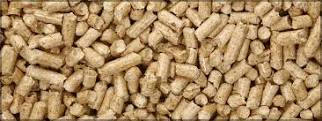Wood pellets are small "nuggets" of compressed, sawdust-size wood fiber (Figure 1). People all over the world use wood pellets to generate heat and energy from renewable resources. Wood pellets are cylindrical with standard diameters of 6 and 8 (± 0.5) mm and lengths up to four times the diameter. Their compact size and portability, their high energy density, their low moisture content (below 10%), and their minimal net carbon output make wood pellets very appealing as a renewable energy source. Adding to their appeal, wood pellets are easily adaptable to automated combustion systems, and, with carefully controlled combustion, their emissions can be rendered marginal. A variety of wood sources (feedstock) can be used to produce pellets. Utilization standards, transportation and capital costs, and availability can be critical limiting factors in feedstock selection.

Usage of wood pellet is varied with objectives. In 100MW large-scale boilers, the shape of wood pellet is only used for transportation and storage, and wood pellet fuel is burned in suspension firing after crushing. This kind of large-scale boiler contributes to local energy supply such as generation of electric power and district heating and cooling system.
On the other hand, medium and small-scale boilers are used as an independent electric power plant in factories or for heating in hospitals and schools. A Pellet stove is another combustion installation that is easy to use in house. These small scale boilers and pellet stoves are very convenient, from the aspect of easy-to-handle and cost efficient for companies and houses when they are keen to introduce bio-energy in their building and save money. This especially applies to pellet stoves, which can be used in the house, has considerable advantage as a heating appliance as against using electricity of fossil fuel heating.
Wood pellets are also used as animal bedding and as kitty litter.
Some energy facts about wood pellets
| 1 Ton of wood pellets is equal to | |
| 120 gallons of heating oil | 16,000 ft³ of natural gas |
| 170 gallons of propane | 4,775 KWh of electricity |
How wood pellets are made
The biomass is first chipped, then ground to the size of sawdust. The biomass is dried to a moisture level <15% and then compressed under huge pressure (45,000psi) into small pellets. During this operation the temperature rises to >160ºC causing the lignin to melt and bind the pellet. The pellets are then cooled and passed over a shaker which removes the bits and dust and the pellets are then bagged and ready to be sent to market.